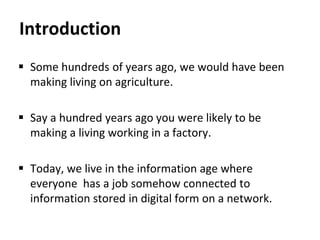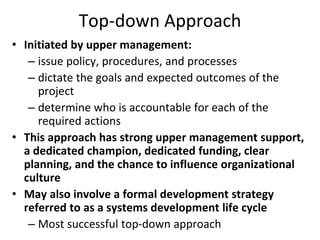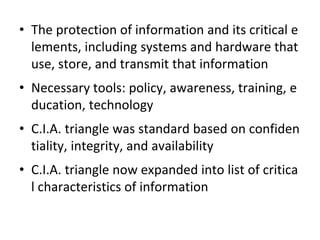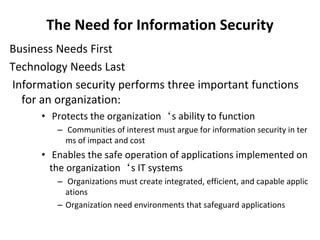chapter 1. Introduction to Information Security
- 1. SQUARE NORTH TECHNOLOGIES Information Security Training Chapter 1 Introduction to Information Security Muhammad Lawal Chief Executive Officer [email protected] 08124350304
- 2. Learning Objectives Understand what information security is and how it came to mean what it does today. Comprehend the history of computer security and how it evolved into information security. Understand the key terms and critical concepts of information security as presented in the chapter. Outline the phases of the security systems development life cycle. Understand the role professionals involved in information security in an organizational structure. Understand the business need for information security. Understand a successful information security program is the responsibility of an organization‘s general management and I T management. Understand the some threats posed to information security and the more common attacks associated with those threats.
- 3. Introduction Some hundreds of years ago, we would have been making living on agriculture. Say a hundred years ago you were likely to be making a living working in a factory. Today, we live in the information age where everyone has a job somehow connected to information stored in digital form on a network.
- 4. The History Of Information Security Computer security began immediately after the first mainframes were developed Physical controls were needed to limit access to authorized personnel to sensitive military locations Only rudimentary controls were available to defend against physical theft, espionage, and sabotage
- 5. The 1960s • Department of Defense’s Advanced Research Project Agency (ARPA) began examining the feasibility of a redundant networked communi cations
- 7. The 1970s and 80s • ARPANET grew in popularity as did its potential for misuse • Fundamental problems with ARPANET security were identified – No safety procedures for dial-up connections to the ARPANET – User identification and authorization to the system were non-existent • In the late 1970s the microprocessor expanded computing capabilities and security threats
- 8. R-609 – The Start of the Study of Computer Security • Information Security began with Rand Report R-609 • The scope of computer security grew from physical security to include: – Safety of the data – Limiting unauthorized access to that data – Involvement of personnel from multiple levels of the organization
- 9. The 1990s • Networks of computers became more common, so too did the need to interconnect the networks • Resulted in the Internet, the first manifestation of a global network of networks • In early Internet deployments, security was treated as a low priority
- 10. The Present • The Internet has brought millions of computer networks into communication with each other – many of them unsecured • Ability to secure each now influenced by the security on every computer to which it is connected
- 11. What is Security? The quality or state of being secure—to be fre e from danger A successful organization should have multipl e layers of security in place: • Physical security • Personal security • Operations security • Communications security • Network security • Information security
- 12. Critical Characteristics of Information • The value of information comes from the char acteristics it possesses: – Availability – Accuracy – Authenticity – Confidentiality – Integrity – Utility – Possession
- 13. Components of an Information System • Information system (IS) is the entire set of software, hardware, data, people, procedures, and networks necessary to use information as a resource in the organisation
- 14. Bottom Up Approach • Security from a grass-roots effort - systems administrators attempt to improve the security of their systems • Key advantage - technical expertise of the individual administrators • Seldom works, as it lacks a number of critical features: – participant support – organizational staying power
- 15. Top-down Approach • Initiated by upper management: – issue policy, procedures, and processes – dictate the goals and expected outcomes of the project – determine who is accountable for each of the required actions • This approach has strong upper management support, a dedicated champion, dedicated funding, clear planning, and the chance to influence organizational culture • May also involve a formal development strategy referred to as a systems development life cycle – Most successful top-down approach
- 17. The Systems Development Life Cycle • Information security must be managed in a manner similar to any other major system implemented in the organization • Using a methodology – ensures a rigorous process – avoids missing steps • The goal is creating a comprehensive security posture/program
- 18. The Security Systems Development Life Cycle • The same phases used in traditional SDLC may be adapte d to support specialized implementation of an IS project • Investigation • Analysis • Logical design • Physical design • Implementation • Maintenance & change • Identification of specific threats and creating controls to counter them • SecSDLC is a coherent program rather than a seri es of random, seemingly unconnected actions
- 20. Investigation • Identifies process, outcomes, goals, and const raints of the project • Begins with enterprise information security po licy • Organizational feasibility analysis is performed
- 21. Analysis • Documents from investigation phase are studied • Analyzes existing security policies or programs, a long with documented current threats and assoc iated controls • Includes analysis of relevant legal issues that co uld impact design of the security solution • The risk management task begins
- 22. Logical Design • Creates and develops blueprints for information secu rity • Incident response actions planned: – Continuity planning – Incident response – Disaster recovery • Feasibility analysis to determine whether project sho uld continue or be outsourced
- 23. Physical Design • Needed security technology is evaluated, alternatives generated, and final design selected • At end of phase, feasibility study determines readiness of organization for project
- 24. Implementation • Security solutions are acquired, tested, implemented, and tested again • Personnel issues evaluated; specific training and education programs conducted • Entire tested package is presented to management for final approval
- 25. Maintenance and Change • Perhaps the most important phase, given the ever-changing threat environment • Often, reparation and restoration of information is a constant duel with an unseen adversary • Information security profile of an organization requires constant adaptation as new threats emerge and old threats evolve
- 26. Professionals involved in information security within an organization Senior Management Chief Information Officer (CIO) • Senior technology officer • Primarily responsible for advising senior executives on strategic planning Chief Information Security Officer (CISO) • Primarily responsible for assessment, management, an d implementation of IS in the organization • Usually reports directly to the CIO
- 27. Information Security Project Team A number of individuals who are experienced in one or more facets of required technical an d nontechnical areas: • Champion • Team leader • Security policy developers • Risk assessment specialists • Security professionals • Systems administrators • End users
- 28. Data Ownership • Data owner: responsible for the security and u se of a particular set of information • Data custodian: responsible for storage, maint enance, and protection of information • Data users: end users who work with informat ion to perform their daily jobs supporting the mission of the organization
- 29. What is Information Security? • “The concepts, techniques, technical measures, and adminis trative measures used to protect information assets from deli berate or inadvertent unauthorised acquisition, damage, discl osure, manipulation, modification, loss, or use is information security.” or • means protecting information and information systems from unauthorised access, use, disclosure, modification or destructi on. or • Implementing suitable controls - policies, practices, procedur es, organisational structures, software, etc, to secure informa tion for any information user.
- 30. • The protection of information and its critical e lements, including systems and hardware that use, store, and transmit that information • Necessary tools: policy, awareness, training, e ducation, technology • C.I.A. triangle was standard based on confiden tiality, integrity, and availability • C.I.A. triangle now expanded into list of critica l characteristics of information
- 31. How Can Information Security Be Achieved Access to network resource will be granted through a unique user ID and password Passwords will be 8 characters long Passwords should include one non-alpha and not found in dictionary Information Security is achieved by implementing a suitable set of controls, which could be: These controls need to be established in order to ensure that the specific security objectives of the organization are met.
- 32. Information Security Goals Confidentiality - making sure that those who should not see the information can not see it. Integrity - making sure the information has not been changed from how it was intended to be. Availability – making sure the information is available for use when needed.
- 34. Securing Components • Computer can be subject of an attack and/or the obj ect of an attack – When the subject of an attack, computer is used as an active tool to conduct attack – When the object of an attack, computer is the entity b eing attacked
- 36. Balancing Information Security and Access • Impossible to obtain perfect security—it is a p rocess, not an absolute • Security should be considered balance betwee n protection and availability • To achieve balance, level of security must allo w reasonable access, yet protect against threa ts
- 37. Balancing security and access
- 38. The Need for Information Security Business Needs First Technology Needs Last Information security performs three important functions for an organization: • Protects the organization‘s ability to function – Communities of interest must argue for information security in ter ms of impact and cost • Enables the safe operation of applications implemented on the organization‘s IT systems – Organizations must create integrated, efficient, and capable applic ations – Organization need environments that safeguard applications
- 39. • Protects the data the organization collects and uses – One of the most valuable assets is data – Without data, an organization loses its record of trans actions and/or its ability to deliver value to its custom ers – An effective information security program is essential to the protection of the integrity and value of the orga nization‘s data Technology Needs • Safeguards the technological assets in use at the organi zation • Organizations must have secure infrastructure services b ased on the size and scope of the enterprise
- 40. Areas of Information System Security Data security Computer security LAN or Network security Internet security
- 41. Major Threats & Issues Basic Threats Theft of password E-mail based threats E-mail based extortion Launch of malicious codes (trojans)
- 42. Corporate threats • Web defacement • Corporate espionage • Website based launch of malicious code cheating and fraud • Exchange of criminal ideas and tools • Cyber harassment • Forge websites Online threats • E-mail spamming • Theft of software and electronic records • Cyber stalking • E-mail bombing • Denial of service attacks
- 43. Protecting your computer and network Physical security Securing desktop computers Securing laptops/notebooks/handheld computers Securing network security Software security Protect against internet intruders with firewall s and IDS Protect against viruses and other malware Protect against spyware and adware Protect against unwanted email
- 44. General spam protection practices Do not give out your email address indiscriminately Leave your email signature line blank if you post to a newsgroup Do not reply to junk messages Do not open obvious spam mails Report to appropriate person – systems administrator
Editor's Notes
- #4: 3











































